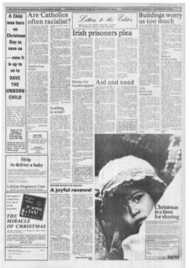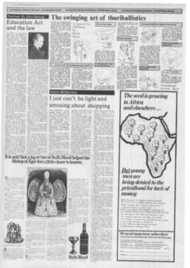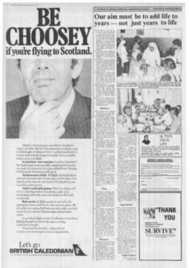Page 9, 3rd December 1976
Page 9

Report an error
Noticed an error on this page?If you've noticed an error in this article please click here to report it.
Tags
Share
Related articles
Let Us Al! Join
Will The Real Santa Claus Please Stand Up?
Don't Tread On Our Dreams
Cutting Through The Tinsel
Santa Claus Is Coming...
How Christmas gifts are brought to many lands
MOST parents in Britain try to make each Christmas memorable for their young children. The time during which children believe in the Santa Claus fantasy is so short that we should be in no hurry to force reality upon them.
We acknowledge St Nicholas as the original Santa Claus, but all over the world there are legends concerning secret deliverers of Christmas joy for children, Young children love secrets, they also love presents — so custom has happily combined these two features at Christmas. But not all presents are opened on Christmas morning, as in Britain.
The feast day of St Nicholas is on December 6, when children in Holland receive their presents. It is a happy day of ceremony, with the traditional Santa Claus figure making his entry into major Dutch cities, riding on a white horse. He is officially received by the burgomaster, then leads a gay procession through the city streets.
After the procession families return to their homes, where they have already hidden
presents for each other in the most inconspicuous places they
can find. Young children are
told that on this day St Nicholas rides through the air on a white
horse, jumping from roof to roof as he delivers presents for them.
In Lorraine, young children hang their stockings by the fireplace on the Eve of St Nicholas's feast day, while in other parts of France children put their shoes by the fireplace on Christmas Eve.
Gifts are distributed on Christmas Eve in Switzerland.
Young children are told that they arrive on a sleigh driven by six fine reindeer.
The main celebrations take place in Sweden on Christmas Eve, starting with the festive meal in a separate room. After the eating, the door of the living room is opened to reveal a beautifully decorated Christmas tree.
The front door of the house is also opened, for children believe that presents are
delivered by the Yulbock, or Yule goat, which according to
their legend, tosses them into the house through the open door.
In North Germany children believe that Knecht Rupert, or Servant Rupert, distributes Christmas gifts.
He is a man who wears a white robe, mask, wig and false beard. He visits each house in the village on Christmas Eve, when he is greeted by the parents and older children. lie requests a report on the behaviour of young children, and distributes gifts accordingly.
Young children regard Knecht Rupert in awe, and they are seven to eight years old before they learn that he is only a man in the village dressed up. In other parts of Germany, children hang up their stockings on Christmas Eve with written requests for gifts. They are told that if they have been good, Krishkinkk will deliver their gifts. If they have a bad record they will be visited by Pelsnichol, who carries nothing but birch rods in his sack.
Obviously, Christmas weather is far more reliable in Mexico than in Britain._ The South American way is to fix all the family presents to a Christmas tree positioned outside the church. MI the family goes to church at midnight on Christmas Eve, but the tree is kept in darkness.
After the service, the congregation comes out of church to find the tree brilliantly illuminated ready for the distribution of gifts.
Christmas is regarded as a specially joyous occasion in Finland, bringing warmth to what is a dark and gloomy time of the year. Here is the traditional home of Father Christmas, or Joutupukkl, as he
is known to Finnish children. They actually see him travelling on a sleigh drawn by real reindeer over firm snow.
Christmas Eve is also the centre of the Finnish celebrations. They put lighted
candles in all windows to welcome members of the family as they arrive. A meal of traditional dishes is eaten and presents are then exchanged. Sheaves of grain are hung on poles near the houses, so that cattle can also share in the family Christmas treat.
In Spain, preparations for Christmas do not start until December 15, but from then
onwards until January 6, everything is geared to the celebration of all aspects of Christmas.
Open-air markets are set up in city squares for the sale of Christmas goods, and with the shopping goes all the fun of the fair, Interspersed with the stalls are coconut shies, shooting galleries, hoopla and other games of chance. Excitement gradually builds up to fever pitch until December 22, the day of the annual draw of the Spanish National Lottery. Six ticket holders receive presents of £300,000 each, and there are some 48,000 money prizes. The most important Spanish festivity is called Noche Buena, which literally means "Good Night," but is the name given to Christmas Eve. It takes the
form of a family gathering for a meal, similar to our Christmas dinner.
In typically Spanish manner, so that families can be together, all shops, cafes and restaurants close early in the evening.
Public transport runs until 9 pm to enable people to reach their homes: then that, too, ceases completely. Noche Buena is strictly a family occasion. Friends are not invited, as they are expected to be present at their own family gathering.
Family presents arc reserved for Epiphany, January 6, which is called Reyes, the Feast of the Kings. On its eve the children stuff their shoes with straw and leave them on the balconies or front doorsteps of their houses.
They are told that during the night the Three Kings will pass by. After feeding their horses on the straw they will leave gifts in return, as they did for the Christ Child.
In Italy, too, gifts are received on Epiphany. Here the children believe that the presents are brought by an old woman named La Befana.
Geoffrey Humphreys
blog comments powered by Disqus













